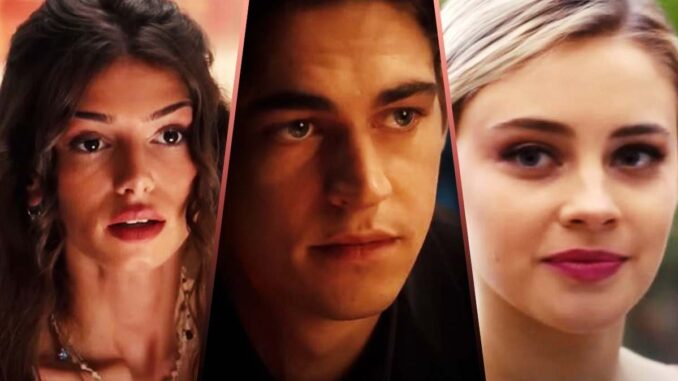
After Everything: The Quiet Dawn After the Storm for Hardin and Tessa
The “After” series, born from Wattpad and exploding into a global phenomenon, plunged readers and viewers alike into the tumultuous, often toxic, yet undeniably magnetic world of Hardin Scott and Tessa Young. Their love story was a maelstrom of passion, jealousy, betrayal, and a codependency that threatened to consume them both. By the time After Everything (the film adaptation of After Ever Happy and the subsequent epilogue) concludes, the burning question for fans is not just “what happens,” but “what finally happens” to a love forged in such intense fire. The ending, far from a conventional fairytale, offers a nuanced and ultimately more mature explanation: it’s not about a neat “happily ever after,” but about individual healing, a redefined connection, and the quiet dawn after years of stormy nights.
To understand the ending, one must first revisit the precipice on which Hardin and Tessa stood. The previous installments left them shattered. Hardin, reeling from the revelation of his true paternity, spiraled into a self-destructive abyss, his long-simmering trauma boiling over. Tessa, after years of trying to fix him, of sacrificing her own identity for their tumultuous bond, finally reached her breaking point, physically and emotionally drained. The ending of After Ever Happy (the book and film preceding After Everything) saw them effectively separated, a necessary distance for their very survival.
After Everything picks up with Hardin at his lowest, adrift in London, wrestling with his demons. His path to redemption is agonizingly slow and deeply personal. He grapples with alcoholism, self-loathing, and the creative block that prevents him from writing the sequel to his hugely successful, thinly veiled autobiography, “After.” The film shows him hitting rock bottom, his room a mess, his life devoid of purpose. But crucially, this time, Tessa isn’t there to pick up the pieces. This forced independence is the catalyst for his true healing. He embarks on therapy, confronts his past traumas with a dedicated professional, and begins to understand the roots of his volatile behavior. His journey is one of self-discovery, learning to love and forgive himself before he can ever hope to sustain a healthy relationship with anyone else. The ultimate triumph for Hardin isn’t winning Tessa back, but finding sobriety, peace, and the ability to finally finish his book – a testament to his growth and self-acceptance.
Meanwhile, Tessa’s journey runs parallel, equally vital and transformative. For years, her narrative was inextricably linked to Hardin’s. Her love for him was all-consuming, often at the expense of her own well-being, ambitions, and boundaries. The separation forces her to reclaim herself. The film shows her thriving in her career, pursuing her own interests, and building a life independent of the chaos Hardin brought. She, too, is in therapy, processing the trauma of their relationship and understanding her own patterns of codependency. Tessa learns to set firm boundaries, to prioritize her mental and emotional health, and to find happiness within herself. She no longer chases Hardin; instead, she lives her life with a newfound sense of autonomy and strength.
The “ending” – the much-anticipated reunion of Hardin and Tessa – is not a grand, dramatic climax. It’s subtle, earned, and significantly different from their previous reconciliations. After a significant time jump, after both have individually undergone immense personal growth, they meet again. Hardin has published his second book, a more mature and hopeful reflection. Tessa attends his book signing, not as a desperate ex-lover, but as a supportive friend and, more importantly, a healed individual.
What happens is this: They acknowledge each other, not with the explosive passion of their past, but with a quiet understanding and a shared history. There’s no immediate embrace, no declaration of eternal love. The film leaves their immediate future ambiguous, but the implication is clear: their bond, though forever changed, still exists. It’s a connection built on mutual respect and the understanding that they are both better, healthier people now. The ending shows them walking off together, into a metaphorical future that is no longer defined by their past toxicity.
The explanation for this kind of ending is profound. The “After” series, despite its fervent fanbase, was often criticized for romanticizing a deeply unhealthy relationship. The conclusion of After Everything serves as a deliberate antidote to that. It illustrates that true love, if it is to endure, must evolve beyond obsessive passion. It teaches that individual healing is paramount; you cannot truly love another until you first love and heal yourself. Hardin and Tessa needed to break apart, to walk separate paths through their respective darkness, to emerge as whole, independent beings capable of a healthier, more sustainable connection.
The absence of a traditional wedding scene or a clear “happily ever after” with children is intentional. It underscores the message that their story isn’t about conforming to societal expectations of romance, but about the arduous journey of self-improvement. Their love, in its final form, is not about ownership or dependency, but about choice, acceptance, and the quiet joy of being truly seen by someone who understands your entire, messy history.
In essence, After Everything explains that Hardin and Tessa don’t “end up” in a conventional sense. Instead, they finally “begin.” They begin a new chapter where their love is a choice made by two mature, healed individuals, free from the chains of their past, ready to build a future based on understanding, respect, and a hard-won peace. It’s an ending that respects the characters’ tumultuous journey, providing not a definitive closure, but a hopeful, realistic sense of what enduring love looks like after everything.
